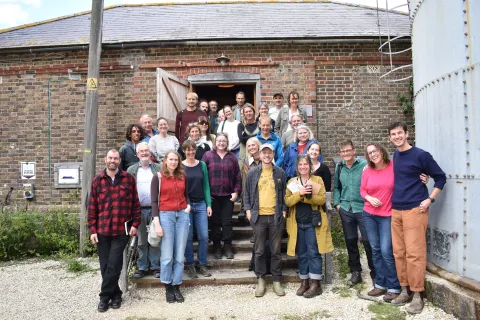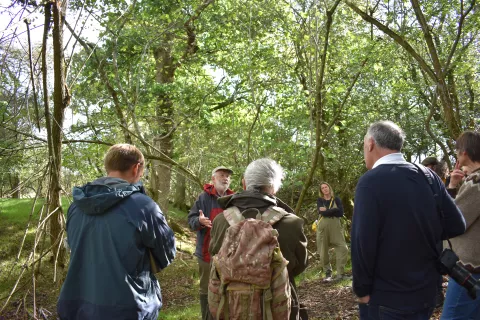
What role can archaeology play in nature recovery? This was the question that brought together over 50 ecologists, archaeologists, artists, geographers, farmers, museum specialists, journalists, and rewilding practitioners at Knepp Castle Estate rewilding project in West Sussex this September. Funded by the UKRI, and co-organised by Oxford Archaeology’s ‘Rewilding’ Later Prehistory project team with Jonathan Last (Historic England) and Sylvie More and Matt Phelps (Knepp), the Archaeology in Wilding workshop marked the culmination of a year-long collaboration between archaeologists, artists, and wilding experts at Oxford Archaeology, Historic England, Knepp Castle Estate, and Hepple Wilds in Northumberland.
The three-day workshop opened with an exhibition featuring original art and photography curated and created by Miranda Creswell and Rose Ferraby. Landscape imagery and photographs of laboratory specimens depicted the diverse ways in which past and present influences on the environment can coexist. The exhibition also launched a specially commissioned booklet on the collaboration, incorporating interviews with a range of archaeological specialists and original art by Rose Ferraby.
Interdisciplinary discussions focused on the practical ways that archaeology can be integrated into nature recovery, including Oxford Archaeology’s Tree Roots and Archaeology and Archaeology and Biodiversity Net Gain projects. Other topics included tackling deer overpopulation with zooarchaeological insight, and how to tell engaging stories about past people and landscapes that help people to ‘imagine change’. Participants took part in hands-on sessions that explored themes at the intersection between wildlife and archaeology, including prehistoric antler working techniques and archaeological and ecological soil experiments.
We created an event that was diverse, original, and buzzing with energy. Hopefully, this has generated a basis, and a strong appetite for more cross-disciplinary working in this vein!”
Dr Anwen Cooper
Rewilding Later Prehistory project lead
The workshop concluded with a trial Archaeology in Wilding ‘safari’, co-designed with Knepp’s expert safari guides and involving diverse specialists – from a local museum curator, a Wealden iron industry researcher and local history groups to archaeologists involved in recent excavations at Knepp and leading researchers in species that are key Knepp’s rewilding vision. These walking tours brought out the human, animal and plant histories that underpin Knepp’s rapidly transforming landscape now.
The next step will be to produce a simple publicly accessible report capturing the workshop’s findings and ideas, and more formal outputs, potentially linking into existing policy documents, and setting down a common agenda and values for developing archaeology’s role in nature recovery projects nationwide.
Together you created a fantastic ‘space’ in which ideas and connections flowed in a very energising and positive way, and I am looking forward to following up on many of these in the coming days”
Workshop attendee

